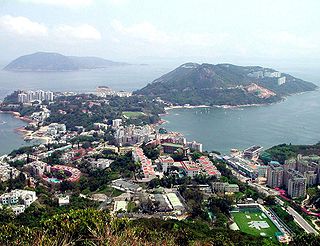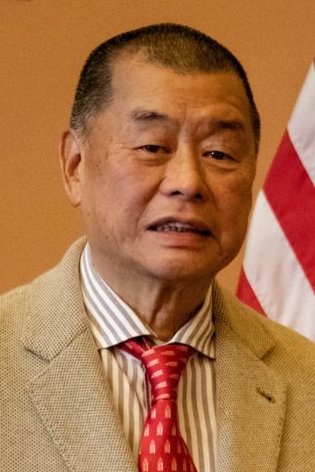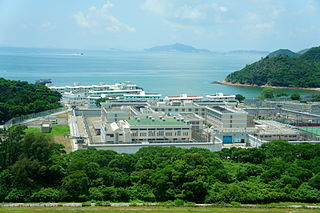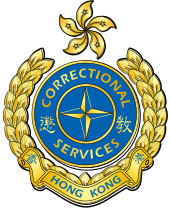
Stanley, or Chek Chue, is a coastal town and a popular tourist attraction in Hong Kong. It is located on a peninsula on Hong Kong Island. It is east of Repulse Bay and west of Shek O, adjacent to Chung Hom Kok and Tai Tam. Administratively, it is part of the Southern District.

Lai Chee-ying, also known as Jimmy Lai, is a Hong Kong businessman and politician. He founded Giordano, an Asian clothing retailer, Next Digital, a Hong Kong-listed media company, and the popular newspaper Apple Daily. He is one of the main contributors to the pro-democracy camp, especially to the Democratic Party. Although he is known as a Hong Kong political figure, he has been a British national since 1996. Lai is also an art collector.

Sha Tau Kok is a closed town in North District, Hong Kong. It is the last remaining major settlement in the Frontier Closed Area and is Hong Kong's northernmost town. Sha Tau Kok District is a rural committee district encompassing 46 villages within North District.
Prisons in Hong Kong are correctional facilities in Hong Kong, which are managed by the Correctional Services Department. Facilities have different purposes. Hong Kong has one of the highest rates of imprisonment in the region.

Chi Ma Wan is a bay on southeastern Lantau Island, New Territories, Hong Kong. Chi Ma Wan Peninsula is where Chi Ma Wan, as well as Cheung Sha Wan, Tai Long Wan, Yi Long Wan and Mong Tung Wan are located. The Peninsula is located within the boundaries of Lantau South Country Park.

Gary Chan Hak-kan, BBS, JP is a current member of the Legislative Council of Hong Kong. He represents the New Territories North East constituency and is a chairperson of the Democratic Alliance for the Betterment and Progress of Hong Kong (DAB) political party.

The former Lai Chi Kok Hospital (Chinese:荔枝角醫院), located at No.800 Castle Peak Road, Lai Chi Kok, Kowloon, was listed as one of the Grade III historic buildings in Hong Kong. It was originally built a prison between 1921 and 1924, then converted into a hospital for infectious deseases around 1930s. The site has now been transformed into Jao Tsung-I Academy under batch 1 of the Hong Kong Government's revitalization scheme.

Shek Pik Prison is a prison in Hong Kong, located at 47 Shek Pik Reservoir Road, Shek Pik, Lantau Island. It was built in 1984, and is managed by the Hong Kong Correctional Services. The prison is used to contain prisoners with medium to long sentences, as well as those sentenced to life imprisonment.

The offices of Apple Daily, once the largest pro-democracy newspaper in Hong Kong, and its parent company, Next Digital, were raided and executives arrested by the Hong Kong Police Force on 10 August 2020 and again on 17 June 2021. Some of the arrested and three companies of Next Digital were charged under the Hong Kong national security law. The 26-year-old newspaper was forced to close in June 2021 following the raids and freezing of its capital.

Lai Chi Kok Reception Centre is a prison in Lai Chi Kok, Kowloon, Hong Kong. It is operated by the Correctional Services Department and is one of the largest prisons in the territory.

Tai Tam Gap Correctional Institution is a prison in Eastern District, Hong Kong, operated by Hong Kong Correctional Services.

Immigration to Hong Kong is the process by which people migrate to the Chinese special administrative region of Hong Kong for the purpose of residing there. The region has its own Hong Kong immigration policy governing how such migration may be carried, including for those immigrating from mainland China.

The penal system of Hong Kong, with its colonial tradition, is responsible for carrying out criminal penalties and the supervision and rehabilitation of former prisoners.

Few protests took place in December 2020 and there was no large-scale demonstrations in threat of the national security law. The imprisonment of Joshua Wong, Agnes Chow and Ivan Lam on 2 December aroused attention of the International community.

A dramatic manifestation of the far reach of the Hong Kong national security law was the mass arrest of 54 pro-democracy activists on 6 January. The arrested stood accused of subverting state power, a crime under the national security law, for their participation as candidates or in other capacities, in the 2020 Hong Kong pro-democracy primaries, which was part of a plan to increase pressure in parliament for democratic reform. Most of them were released on bail the following day. For the first time, the National Security Department of the police cited the national security law to block the website of HKChronicles. There were also several convictions in relation to the 2019-2020 Hong Kong protests.

Few protests took place in March 2021 and there was no large-scale demonstrations in threat of the national security law. The charge against 47 pro-democracy activists for subversion on participating in a primary election was widely condemned by international community.

On 14 May, authorities froze the assets of pro-democracy media tycoon Jimmy Lai. This was the first time that the pertaining provision in Article 43 of the national security law was applied. While Chief Executive Carrie Lam said on 18 May that the move would serve to bolster the status of Hong Kong as an international financial hub, several senior bankers and corporate lawyers not associated with Lai's accounts opined that the action – which was followed at the end of the month by a warning from the Security Secretary to banks against dealing with the frozen assets – was exposing risks for clients and top financial managers in Hong Kong.

Few protests took place in June 2021 and there were no large-scale demonstrations in threat of the national security law. The anniversary of the 1989 Tiananmen Square protests and massacre on 4 June saw only small crowds or single individuals engaging in vigils in the vicinity of Victoria Park – the venue of large vigils on the same occasion in past years – before police dispersed them. The pro-democracy tabloid Apple Daily once again had its headquarters raided by police using the national security law; its executives were arrested. Security Bureau also froze the assets of three Apple Daily companies, which led the newspaper to print its final edition on 24 June. Many pan-democratic groups disbanded at the end of the month under pressure from the law.

After the 1 July police stabbing, Hong Kong police and the government characterized the incident as a "lone wolf" terrorist attack. Foreign media saw the stabbing as a sign of a steep decline of the reputation of the police in the eyes of some locals, a process that had begun with the 2019–2020 Hong Kong protests. They also considered the uncovering of a bomb plot on 5 July as evidence of a polarization in society, and pointed to the influence of diminishing legal ways to voice dissent in the year since the national security law came into effect. At the beginning of the month, the police arrested citizens who posted on the Internet for inciting others to kill the police. Later it persecuted members of the student union of Hong Kong University for having passed a motion, subsequently withdrawn, that had praised the "sacrifice" of the deceased attacker of 1 July.
















